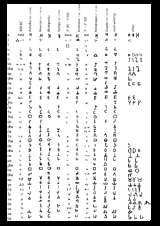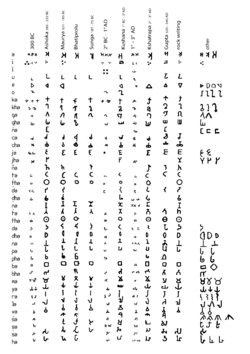
Gupta script
Encyclopedia
The Gupta script was used for writing Sanskrit
and is associated with the Gupta Empire
of India
which was a period of material prosperity and great religious
and scientific
developments. The Gupta script was descended from Brahmi
and gave rise to the Nagari, Sharada
and Siddham scripts. These scripts in turn gave rise to many of the most important scripts of India, including Devanagari
(the most common script used for writing Sanskrit
since the 19th Century), the Gurmukhi script
for Punjabi Language
and the Tibetan script
.
 The Gupta Script was descended from the Ashokan Brahmi script
The Gupta Script was descended from the Ashokan Brahmi script
, and is a crucial link between Brahmi and most other scripts in the Brahmic family
of Scripts, a family of alphasyllabaries or abugidas. This means that while only consonantal phonemes have distinct symbols, vowels are marked by diacritics, with /a/ being the implied pronunciation when the diacritic is not present. In fact, the Gupta script works in exactly the same manner as its predecessor and successors, and only the shapes and forms of the graphemes and diacritics are different.
Through the 4th Century AD, letters began to take more cursive and symmetric forms, as a result of the desire to write more quickly and aesthetically. This also meant that the script became more differentiated throughout the Empire, with regional variations which have been broadly classified into three, four or five categories; however, a definitive classification is not clear, because even on a single inscription, there may be variation in how a particular symbol is written. In this sense, the term Gupta script should be taken to mean any form of writing derived from the Gupta period, even though there may be a lack of uniformity in the scripts.
, it describes Samudragupta’s reign, beginning from his ascension to the throne as the second king of the Gupta Dynasty and including his conquest of other kings.
s in 1783. Many other such hoards have since been discovered, the most important being the Bayana
hoard, discovered in 1946, which contained more than 2000 gold coins issued by the Gupta Kings. Many of the Gupta Empire’s coins bear inscriptions of legends or mark historic events. In fact, it was one of the first Indian Empires to do so, probably as a result of its unprecedented prosperity. Almost every Gupta king issued coins, beginning with its first king, Chandragupta I
.
The scripts on the coin are also of a different nature compared to scripts on pillars, due to conservatism regarding the coins that were to be accepted as currency, which would have prevented regional variations in the script from manifesting on the coinage. Moreover, space was more limited especially on their silver coins, and thus many of the symbols are truncated or stunted. An example is the symbol for /ta/ and /na/, which were often simplified to vertical strokes.
Sanskrit
Sanskrit , is a historical Indo-Aryan language and the primary liturgical language of Hinduism, Jainism and Buddhism.Buddhism: besides Pali, see Buddhist Hybrid Sanskrit Today, it is listed as one of the 22 scheduled languages of India and is an official language of the state of Uttarakhand...
and is associated with the Gupta Empire
Gupta Empire
The Gupta Empire was an ancient Indian empire which existed approximately from 320 to 550 CE and covered much of the Indian Subcontinent. Founded by Maharaja Sri-Gupta, the dynasty was the model of a classical civilization. The peace and prosperity created under leadership of Guptas enabled the...
of India
India
India , officially the Republic of India , is a country in South Asia. It is the seventh-largest country by geographical area, the second-most populous country with over 1.2 billion people, and the most populous democracy in the world...
which was a period of material prosperity and great religious
Religion
Religion is a collection of cultural systems, belief systems, and worldviews that establishes symbols that relate humanity to spirituality and, sometimes, to moral values. Many religions have narratives, symbols, traditions and sacred histories that are intended to give meaning to life or to...
and scientific
Science
Science is a systematic enterprise that builds and organizes knowledge in the form of testable explanations and predictions about the universe...
developments. The Gupta script was descended from Brahmi
Brāhmī script
Brāhmī is the modern name given to the oldest members of the Brahmic family of scripts. The best-known Brāhmī inscriptions are the rock-cut edicts of Ashoka in north-central India, dated to the 3rd century BCE. These are traditionally considered to be early known examples of Brāhmī writing...
and gave rise to the Nagari, Sharada
Sarada script
The Śāradā, or Sharada, script is an abugida writing system of the Brahmic family of scripts, developed around the 8th century. It was used for writing Sanskrit and Kashmiri. The Gurmukhī script was developed from Śāradā...
and Siddham scripts. These scripts in turn gave rise to many of the most important scripts of India, including Devanagari
Devanagari
Devanagari |deva]]" and "nāgarī" ), also called Nagari , is an abugida alphabet of India and Nepal...
(the most common script used for writing Sanskrit
Sanskrit
Sanskrit , is a historical Indo-Aryan language and the primary liturgical language of Hinduism, Jainism and Buddhism.Buddhism: besides Pali, see Buddhist Hybrid Sanskrit Today, it is listed as one of the 22 scheduled languages of India and is an official language of the state of Uttarakhand...
since the 19th Century), the Gurmukhi script
Gurmukhi script
Gurmukhi is the most common script used for writing the Punjabi language. An abugida derived from the Laṇḍā script and ultimately descended from Brahmi, Gurmukhi was standardized by the second Sikh guru, Guru Angad Dev Ji, in the 16th century. The whole of the Sri Guru Granth Sahib Ji's 1430...
for Punjabi Language
Punjabi language
Punjabi is an Indo-Aryan language spoken by inhabitants of the historical Punjab region . For Sikhs, the Punjabi language stands as the official language in which all ceremonies take place. In Pakistan, Punjabi is the most widely spoken language...
and the Tibetan script
Tibetan script
The Tibetan alphabet is an abugida of Indic origin used to write the Tibetan language as well as the Dzongkha language, Denzongkha, Ladakhi language and sometimes the Balti language. The printed form of the alphabet is called uchen script while the hand-written cursive form used in everyday...
.
Origins and Classification

Brāhmī script
Brāhmī is the modern name given to the oldest members of the Brahmic family of scripts. The best-known Brāhmī inscriptions are the rock-cut edicts of Ashoka in north-central India, dated to the 3rd century BCE. These are traditionally considered to be early known examples of Brāhmī writing...
, and is a crucial link between Brahmi and most other scripts in the Brahmic family
Brahmic family
The Brahmic or Indic scripts are a family of abugida writing systems. They are used throughout South Asia , Southeast Asia, and parts of Central and East Asia, and are descended from the Brāhmī script of the ancient Indian subcontinent...
of Scripts, a family of alphasyllabaries or abugidas. This means that while only consonantal phonemes have distinct symbols, vowels are marked by diacritics, with /a/ being the implied pronunciation when the diacritic is not present. In fact, the Gupta script works in exactly the same manner as its predecessor and successors, and only the shapes and forms of the graphemes and diacritics are different.
Through the 4th Century AD, letters began to take more cursive and symmetric forms, as a result of the desire to write more quickly and aesthetically. This also meant that the script became more differentiated throughout the Empire, with regional variations which have been broadly classified into three, four or five categories; however, a definitive classification is not clear, because even on a single inscription, there may be variation in how a particular symbol is written. In this sense, the term Gupta script should be taken to mean any form of writing derived from the Gupta period, even though there may be a lack of uniformity in the scripts.
Inscriptions
The surviving inscriptions of the Gupta script are mostly found on iron or stone pillars, and on gold coins from the Gupta Dynasty. One of the most important was the Allahabad Prasasti. Composed by Harishena, the court poet and minister of SamudraguptaSamudragupta
Samudragupta , ruler of the Gupta Empire , and successor to Chandragupta I, is considered to be one of the greatest military geniuses in Indian history according to Historian V. A. Smith. His name is taken to be a title acquired by his conquests...
, it describes Samudragupta’s reign, beginning from his ascension to the throne as the second king of the Gupta Dynasty and including his conquest of other kings.
Alphabet
| a | i | u | ṛ | e | o |
| ā | au |
| k | kh | g | gh | ṅ |
| c | ch | j | jh | ñ |
| ṭ | ṭh | ḍ | ḍh | ṇ |
| t | th | d | dh | n |
| p | ph | b | bh | m |
| y | r | l | v | |
| ś | ṣ | s | h |
Gupta Numismatics
The serious study of Gupta coins began with the discovery of a hoard of gold coinGold coin
A gold coin is a coin made mostly or entirely of gold. Gold has been used for coins practically since the invention of coinage, originally because of gold's intrinsic value...
s in 1783. Many other such hoards have since been discovered, the most important being the Bayana
Bayana
Bayana is a historical town in Bharatpur district of Rajasthan in India. It is a historical city founded by Banasur, who was an Asura. He lived during the time of Krishna...
hoard, discovered in 1946, which contained more than 2000 gold coins issued by the Gupta Kings. Many of the Gupta Empire’s coins bear inscriptions of legends or mark historic events. In fact, it was one of the first Indian Empires to do so, probably as a result of its unprecedented prosperity. Almost every Gupta king issued coins, beginning with its first king, Chandragupta I
Chandragupta I
The Gupta dynasty first seems to be in eminence with the accession of Chandra Gupta I, son of Ghatotkacha to the throne of the ancestral Gupta kingdom. While his two ancestors were given the title of Maharaja , Chandra Gupta I is described in his inscriptions as Maharajadhiraj signifying a rise in...
.
The scripts on the coin are also of a different nature compared to scripts on pillars, due to conservatism regarding the coins that were to be accepted as currency, which would have prevented regional variations in the script from manifesting on the coinage. Moreover, space was more limited especially on their silver coins, and thus many of the symbols are truncated or stunted. An example is the symbol for /ta/ and /na/, which were often simplified to vertical strokes.
External links
The Gupta Alphabet- AncientScripts.com entry on the Gupta Script
- The Shivlee Collection of Coins from the Gupta Dynasty In particular, note the limited space on the silver coins
- An eastern variety of the post-Gupta script: Akṣara List of theManuscripts of the Mūlamadhyamakakārikā and Buddhapālita's Commentary, ca. the 550-650 CE, Collection of Sanskrit Mss. Formerly Preserved in the China Ethnic Library

